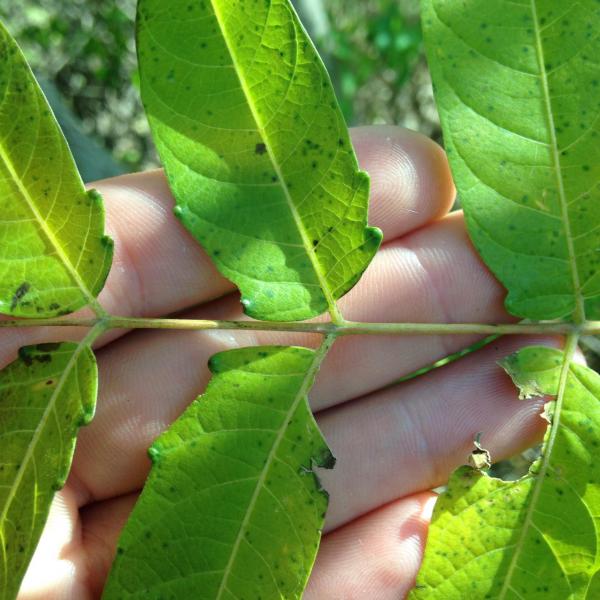
News Source
"Ohio is taking a swing at nature’s bullies.
Under new rules that went into effect Sunday, the sale and distribution of 38 destructive, invasive plant species will become illegal.
In its list, the state agriculture department included various types of honeysuckles, Bradford pear trees, autumn olive shrubs and fig buttercup flowers that line freeways, coat forest floors and choke wild spaces across Ohio.
State officials who already inspect nurseries and garden centers will keep an eye out for the now-prohibited species.
Many of the plants were at some point nursery favorites for desirable qualities such as fast growth, low maintenance and big leaves and flowers — traits that also make them capable of aggressively spreading beyond garden beds to parks and preserves.
“A lot of these species offer all those qualities people look for when they’re buying a plant; there’s demand for them,” said Alistair Reynolds, a forester for the Ohio Department of Natural Resources. “Up until now, we didn’t have any rules preventing the sale of them. There were no rules keeping them from getting into Ohio.”
This month, the Ohio Department of Agriculture also will assemble a five-person invasive plant advisory committee to review potential future additions to the no-sale list, agricultural administrator Dan Kenny said.
Biologists say there’s no time to waste.
“Plants evolved over millions of years. But invasives suddenly start spreading,” said Theresa Culley, a University of Cincinnati plant biologist. “Rather than waiting millions of years for an environment to change, it can take a few years.”
With speed and aggression, the newly prohibited invasive plants often consume, infect, out-compete and steal precious water or sunlight from Ohio’s 174 endangered or threatened wildlife species.
Phragmites, a common reed grass pervasive in northern Ohio, for example, casts a shadow over native neighbors by towering upward of 12 feet.
Garlic mustard can release chemicals in the ground that prevent native plant seeds from germinating.
Kudzu — the vine that swallowed the South — has begun to coat buildings, cars and electric power lines in Ohio’s southern regions.
“They elbow out and swamp out everything else. It’s not natural,” Culley said.
Several of them do more than crowd out native species or alter an area’s water and soil.
Ohio State researchers have found bush honeysuckle plants can negatively impact the genetic fitness of Ohio’s state bird, the cardinal. And the Japanese barberry shrub has been linked to increased tick population and incidence of Lyme disease.
“We may not see it with the naked eye when we’re walking through the woods, but it’s happening,” Reynolds said. “You see something really pretty, but you don’t see the damage.”
Invasive species can also lessen the property value of natural spaces while surging the expense of never-ending battles to hedge their presence using chemicals and hand weeding.
At least half of the 50,000 non-native species introduced to the United States are plants, which wreak more than $34 billion a year in environmental, agricultural, industrial and public health damage, according to the Ohio Invasive Plant Council.
“You can eliminate an invasive, but you’re always doing follow-up. A lot of money goes into this,” said Karen Siedel, a conservation project manager for the Nature Conservancy, which oversees 1,500 acres of wild space in central Ohio. “I don’t know that many people addressing invasive species would say there’s sufficient funding. We could use a lot more.”
The agriculture department’s no-sale list is a good first step, said Jim Bissell, botany curator and director of natural areas for the Cleveland Museum of Natural History.
“These are among the worst,” Bissell said. “Some of these things are so rampant and widespread, unchecked they would cover every floodplain in Ohio.”
The list will limit plant selection available to nurseries and landscape artists, said Andy Doesburg, president of Thornton Landscape based in Maineville, a village in Warren County. But it’s a small setback compared to the benefit of instructing professional landscapers that species do more harm than good.
“We’re embracing this. I can’t argue with it, I’ve seen the impact,” Doesburg said. “We want to be good stewards of the environment. We want to do right.”
Land managers are waging costly battles against invasive species across the state, including the exotic emerald ash borer, zebra and quagga mussels, Asian carp, the West Nile virus and the bat-killing white-nose syndrome.
“We seem to get new mosquitoes, new insects, new plants and animals every growing season,” Reynolds said. “We’re behind the ball; we’re going to have to work really hard. It’s a growing problem. It’s not going away.”
Ohio invasive species:
(1) Ailanthus altissima, tree-of-heaven;
(2) Alliaria petiolata, garlic mustard
(3) Berberis vulgaris, common barberry;
(4) Butomus umbellatus, flowering rush;
(5) Celastrus orbiculatus, oriental bittersweet;
(6) Centaurea stoebe ssp. Micranthos, spotted knapweed;
(7) Dipsacus fullonum, common teasel;
(8) Dipsacus laciniatus, cutleaf teasel;
(9) Egeria densa Brazilian, elodea;
(10) Elaeagnus angustifolia, russian olive;
(11) Elaeagnus umbellata, autumn olive;
(12) Epilobium hirsutum; hairy willow herb;
(13) Frangula alnus, glossy buckthorn;
(14) Heracleum mantegazzianum, giant hogweed;
(15) Hesperis matronlis, dame’s rocket;
(16) Hydrilla verticillata, hydrilla;
(17) Hydrocharis morsus-ranae, european frog-bit;
(18) Lonicera japonica, japanese honeysuckle;
(19) Lonicera maackii, amur honeysuckle;
(20) Lonicera morrowii, morrow’s honeysuckle;
(21) Lonicera tatarica, tatarian honeysuckle;
(22) Lythrum salicaria, purple loosestrife;
(23) Lythrum virgatum, european wand loosestrife;
(24) Microstegium vimineum, japanese stiltgrass;
(25) Myriophyllum aquaticum, parrotfeather;
(26) Myriophyllum spicatum, eurasian water-milfoil;
(27) Nymphoides peltata, yellow floating heart;
28) Phragmites australis, common reed;
(29) Potamogeton crispus, curly-leaved pondweed;
(30) Pueraria montana var. lobate, kudzu;
(31) Pyrus calleryana, callery pear;
(32) Ranunculus ficaria, fig buttercup/lesser celandine;
(33) Rhamnus cathartica, european buckthorn;
(34) Rosa multiflora; multiflora rose
(35) Trapa natans, water chestnut;
(36) Typha angustifolia, narrow-leaved cattail;
(37) Typha x glauca, hybrid cattail;
and (38) Vincetoxicum nigrum, black dog-strangling vine, black swallowwort."
Author Credit: By Marion Renault, The Columbus Dispatch
Photo Credit: VT FPR- Tree-of-Heaven